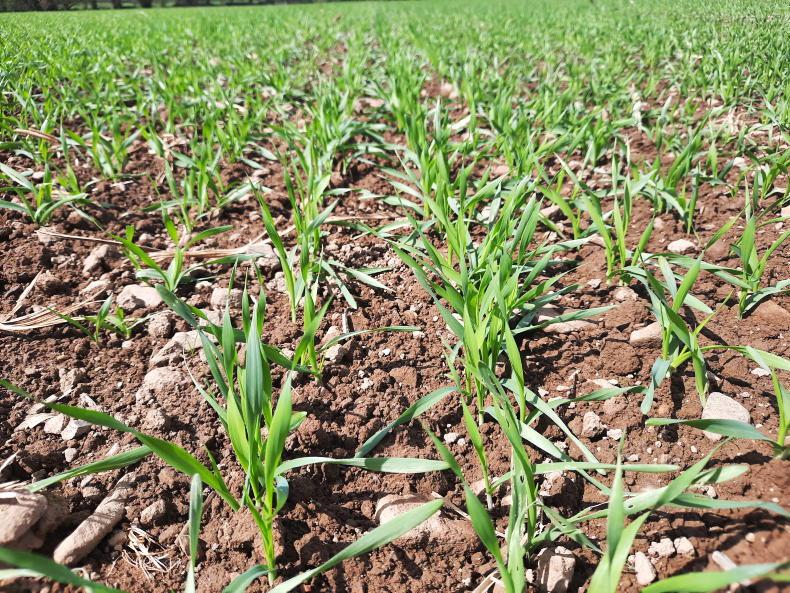Nutrient deficiencies in crops lead to yield reductions. This is because plants are lacking nutrients essential for different processes such as building root structure and cell walls.
Nutrient deficiencies can lead to stress which leads to disease and further reductions in yield.
Some nutrients have a bigger effect on crop growth than others, eg a lack of nitrogen will severely limit yield.
However, nutrient deficiencies such as magnesium or manganese are very common and can have a massive impact on crop performance if left untreated.
Tackling nutrient deficiencies early is essential. Keeping the deficiency at bay will help to decrease the impact it has on the crop. So acting early is essential.
Many people will know the history of their fields. They will know that one field every year has a certain deficiency or that there is a deficiency common to the area or the soil type.
Testing plants early in the season for nutrient deficiencies and applying nutrients to the plant can help to tackle that nutrient deficiency problem for the season ahead
In this case, a seed dressing or fertiliser which has other nutrients apart from nitrogen (N), phosphorus (P) and potassium (K) blended in the mix can help from the minute the seed is in the ground.
Testing plants early in the season for nutrient deficiencies and applying nutrients to the plant can help to tackle that nutrient deficiency problem for the season ahead.
However, it is important to improve soil health and therefore improve nutrient availability from that soil.
The addition of organic manures and the use of cover cropping can help to improve soil health and therefore make nutrients more available.
However, some soil may be prone to a deficiency and it can be difficult to overcome. Soil tests should also look at other nutrients apart from N, P and K.
Leaf samples
We took leaf samples on some of the Footprint Farms over the past few weeks.
Spring crops were the main target.
Sampling at the two- to three-leaf stage this year allowed for time between testing in the lab and application of the herbicide. Foliar nutrition can be applied with the herbicide spray on spring crops.
Samples were taken in a W-shape, similar to taking a soil sample. About 40 small plants are needed for testing in the lab and depending on field size you may need to take a sample from about 20 different locations.

A crop of spring barley.
The roots should be clipped from the samples using a clean scissors.
If there is a problem area in the field it may be best to sample this separately, so leave it out of the main sample.
Samples should go to the lab as soon as possible. They can be sent by post and generally take about five days to be analysed and the results sent back.

Plant tissue samples to be sent to the lab.
Results will come back from labs in different forms, but they will often give the nutrient content in mg/kg and this result will be described as low, medium or high range for a certain nutrient.
The samples were tested for the following: nitrogen, phosphorus, potassium, calcium, magnesium, sulphur, boron, copper, zinc, manganese, iron and aluminium.
Samples will vary in cost between labs, so shop around for the best price. Your local merchant, agronomist or crop nutritionist will often send samples to be tested or many labs which test soil will also carry out plant tissue tests.
Results
Looking at the results which came from the lab so far, magnesium was the most common deficiency, with all samples reading deficient in magnesium, some lower than others.
Manganese followed, again varying in severity of a deficiency. Copper and zinc were also common deficiencies, but were not as prevalent as magnesium and manganese.
Readings were generally good for nitrogen, phosphorus, potassium and sulphur.
What next?
Farmers should talk to their agronomist and develop a strategy to tackle the deficiency.
At this stage in the season, foliar feeds are probably the best option. There should be an early application with the weed spray and a second application may be needed.
Some deficiencies will be worse than others, so a mix of nutrients might be sufficient where there are a number of deficiencies, but if an important nutrient is very low then it may need to be applied as a straight product.
If the deficiency is recurring in the field then a wider plan needs to be developed to improve soil health or tackle the deficiency with granular fertiliser or with a seed dressing.
Some deficiencies will be seasonal and may be affected by the weather. Keeping notes on different crops and fields is important. important.
Sample early.Sample in a “W” pattern.You will need approximately 40 plants.Clip the roots from the bottom of the plant.Deliver to the lab or send in the post as soon as possible.Place in a plastic sample bag.Label clearly.Magnesium: can reduce chorophyll needed for photosynthesis. Stunts growth and reduces yield.Manganese: important for chlorophyll. Can result in yield losses of 30% to 60%.Copper: important for ear formation and grain development.Zinc: helps to transform carbohydrates and regulates sugars, helps with moisture uptake.Treat nutrient deficiencies early.Severe deficiencies may need a higher rate applied or two applications.If there are a number of deficiencies a mix might be a good option, depending on how bad a certain deficiency is.Record deficiencies for the following season.
Nutrient deficiencies in crops lead to yield reductions. This is because plants are lacking nutrients essential for different processes such as building root structure and cell walls.
Nutrient deficiencies can lead to stress which leads to disease and further reductions in yield.
Some nutrients have a bigger effect on crop growth than others, eg a lack of nitrogen will severely limit yield.
However, nutrient deficiencies such as magnesium or manganese are very common and can have a massive impact on crop performance if left untreated.
Tackling nutrient deficiencies early is essential. Keeping the deficiency at bay will help to decrease the impact it has on the crop. So acting early is essential.
Many people will know the history of their fields. They will know that one field every year has a certain deficiency or that there is a deficiency common to the area or the soil type.
Testing plants early in the season for nutrient deficiencies and applying nutrients to the plant can help to tackle that nutrient deficiency problem for the season ahead
In this case, a seed dressing or fertiliser which has other nutrients apart from nitrogen (N), phosphorus (P) and potassium (K) blended in the mix can help from the minute the seed is in the ground.
Testing plants early in the season for nutrient deficiencies and applying nutrients to the plant can help to tackle that nutrient deficiency problem for the season ahead.
However, it is important to improve soil health and therefore improve nutrient availability from that soil.
The addition of organic manures and the use of cover cropping can help to improve soil health and therefore make nutrients more available.
However, some soil may be prone to a deficiency and it can be difficult to overcome. Soil tests should also look at other nutrients apart from N, P and K.
Leaf samples
We took leaf samples on some of the Footprint Farms over the past few weeks.
Spring crops were the main target.
Sampling at the two- to three-leaf stage this year allowed for time between testing in the lab and application of the herbicide. Foliar nutrition can be applied with the herbicide spray on spring crops.
Samples were taken in a W-shape, similar to taking a soil sample. About 40 small plants are needed for testing in the lab and depending on field size you may need to take a sample from about 20 different locations.

A crop of spring barley.
The roots should be clipped from the samples using a clean scissors.
If there is a problem area in the field it may be best to sample this separately, so leave it out of the main sample.
Samples should go to the lab as soon as possible. They can be sent by post and generally take about five days to be analysed and the results sent back.

Plant tissue samples to be sent to the lab.
Results will come back from labs in different forms, but they will often give the nutrient content in mg/kg and this result will be described as low, medium or high range for a certain nutrient.
The samples were tested for the following: nitrogen, phosphorus, potassium, calcium, magnesium, sulphur, boron, copper, zinc, manganese, iron and aluminium.
Samples will vary in cost between labs, so shop around for the best price. Your local merchant, agronomist or crop nutritionist will often send samples to be tested or many labs which test soil will also carry out plant tissue tests.
Results
Looking at the results which came from the lab so far, magnesium was the most common deficiency, with all samples reading deficient in magnesium, some lower than others.
Manganese followed, again varying in severity of a deficiency. Copper and zinc were also common deficiencies, but were not as prevalent as magnesium and manganese.
Readings were generally good for nitrogen, phosphorus, potassium and sulphur.
What next?
Farmers should talk to their agronomist and develop a strategy to tackle the deficiency.
At this stage in the season, foliar feeds are probably the best option. There should be an early application with the weed spray and a second application may be needed.
Some deficiencies will be worse than others, so a mix of nutrients might be sufficient where there are a number of deficiencies, but if an important nutrient is very low then it may need to be applied as a straight product.
If the deficiency is recurring in the field then a wider plan needs to be developed to improve soil health or tackle the deficiency with granular fertiliser or with a seed dressing.
Some deficiencies will be seasonal and may be affected by the weather. Keeping notes on different crops and fields is important. important.
Sample early.Sample in a “W” pattern.You will need approximately 40 plants.Clip the roots from the bottom of the plant.Deliver to the lab or send in the post as soon as possible.Place in a plastic sample bag.Label clearly.Magnesium: can reduce chorophyll needed for photosynthesis. Stunts growth and reduces yield.Manganese: important for chlorophyll. Can result in yield losses of 30% to 60%.Copper: important for ear formation and grain development.Zinc: helps to transform carbohydrates and regulates sugars, helps with moisture uptake.Treat nutrient deficiencies early.Severe deficiencies may need a higher rate applied or two applications.If there are a number of deficiencies a mix might be a good option, depending on how bad a certain deficiency is.Record deficiencies for the following season. 







 This is a subscriber-only article
This is a subscriber-only article










SHARING OPTIONS: